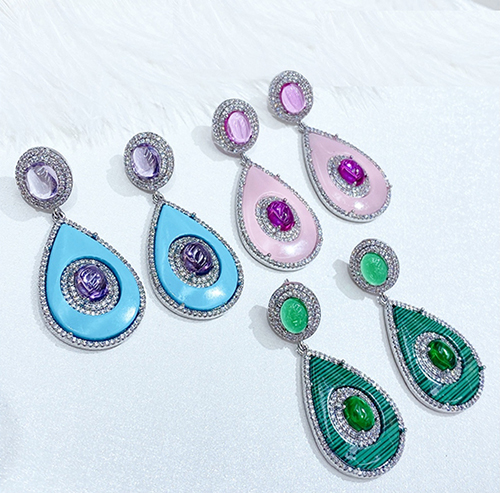Tel: +86-19858962331
Email: sales@handierjewelry.com
 English
English
When selecting brass for jewelry making, it’s crucial to choose materials that offer the right balance of durability, aesthetic appeal, and safety. Brass is a copper-zinc alloy, and it’s one of the most popular metals used in jewelry for its golden appearance, workability, and affordability. Here’s how to choose brass jewelry materials and the standards they should meet:
1. Material Composition
·Copper-Zinc Ratio: Brass is primarily an alloy of copper and zinc, but the exact ratio of these two metals can vary. Brass with a higher copper content (e.g., 70% copper, 30% zinc) tends to have a richer, warmer color, while brass with a higher zinc content (e.g., 60% copper, 40% zinc) tends to have a paler, more yellowish hue. For jewelry, 70% copper to 30% zinc is a common ratio for both its appearance and durability.
·Other Alloying Elements: Some brass alloys may contain small amounts of other elements like lead, tin, or nickel to improve specific properties such as machinability or corrosion resistance. However, these elements should be used cautiously to avoid toxicity or allergic reactions.
2. Safety and Skin Sensitivity
·Lead-Free Brass: When selecting brass for jewelry, it's essential to ensure the alloy is lead-free. Lead is toxic and can leach out of jewelry when worn on the skin, so avoid any brass that contains lead (sometimes used in brass alloys to improve machinability).
·Nickel-Free: Nickel can cause allergic reactions in some people, so it’s best to choose brass alloys that are nickel-free or those that contain very low levels of nickel to minimize the risk of skin irritation.
·Cadmium-Free: Like lead, cadmium is toxic and should not be present in brass alloys used for jewelry. Ensure that the brass you choose is cadmium-free.
3. Durability and Strength
·Corrosion Resistance: Brass is naturally resistant to rust and corrosion due to the copper content, but its zinc component can be prone to oxidation over time, leading to tarnishing. To ensure long-lasting wear, it’s advisable to choose brass alloys that are designed to resist tarnish and corrosion, or opt for protective coatings (such as lacquers or plating) to help preserve the finish.
·Hardness and Malleability: Brass alloys vary in hardness depending on their zinc content. A higher zinc content usually results in a harder brass, which may be more prone to cracking or difficulty in shaping. Lower zinc content typically produces a more malleable brass, which is easier to work with for intricate designs but may be softer and more prone to scratches.
·Workability: Brass is relatively easy to work with and can be cast, engraved, and soldered with ease. However, different brass alloys have different levels of malleability, so choose the one that fits your specific jewelry-making technique (e.g., casting, stamping, or forging).
4. Appearance and Finish
·Color and Luster: Brass has a characteristic golden or yellow appearance, which makes it a popular alternative to gold. The color can vary depending on the copper-to-zinc ratio. If a brighter, more golden finish is desired, choose a brass alloy with a higher copper content.
·Patina and Oxidation: Over time, brass may develop a patina (a greenish or brownish tarnish). While some people appreciate the aged look, others prefer to maintain the brass’s original appearance. For this reason, consider using protective coatings, lacquer, or plating (such as gold plating or rhodium plating) to maintain a shiny and tarnish-free finish.
·Polish and Texture: Brass can be polished to a high shine, or left with a more matte, brushed, or antiqued finish. Choose a brass alloy that works well with the desired finish technique.
5. Environmental and Ethical Considerations
·Recycled Brass: Brass is a metal that can be easily recycled, so consider using recycled brass in your jewelry-making process. Recycled metals are often more environmentally friendly and help reduce the need for mining new raw materials.
·Sustainable Sourcing: Ensure the brass you choose is ethically sourced, especially if it’s part of a larger jewelry collection. Avoid brass from sources that exploit workers or damage the environment.
6. Industry Standards and Certifications
·RoHS Compliance: Brass jewelry should be compliant with RoHS (Restriction of Hazardous Substances) regulations, which restrict the use of hazardous materials such as lead, cadmium, mercury, and certain phthalates in consumer products.
·Nickel Release Testing: Brass used for jewelry should comply with EN 1811 (Nickel Release Directive), which measures the amount of nickel that can be released from the metal. This is particularly important for people with nickel allergies.
·Allergen-Free Standards: If creating jewelry for sensitive individuals, choose nickel-free and hypoallergenic brass alloys that meet international skin contact and allergy-safe standards.
7. Alloy Variations for Specific Purposes
·Aluminum Brass: A brass alloy that contains aluminum (often 10–15%) in addition to copper and zinc. This alloy is known for its higher corrosion resistance and is commonly used in jewelry that will be exposed to the elements or worn frequently.
·Silicon Brass: This alloy includes silicon and offers improved casting ability and greater durability compared to traditional brass. It’s commonly used in casting detailed jewelry designs.
·Red Brass: A type of brass with a higher copper content (usually 85% copper, 15% zinc), giving it a reddish color. Red brass is often chosen for its stronger appearance and durability.
8. Considerations
When choosing brass jewelry materials, focus on:
Ensuring the alloy is lead-free, nickel-free, and cadmium-free to guarantee safety.
Selecting a copper-to-zinc ratio that meets your aesthetic and durability needs (higher copper content for a richer color, higher zinc for more strength).
Opting for brass alloys that have been treated to resist tarnishing or oxidation, if needed.
·Considering workability for your specific jewelry-making techniques (casting, engraving, or forging).
Ensuring compliance with safety and environmental standards, such as RoHS and Nickel Release Regulations.
By selecting brass that meets these criteria, you can create jewelry that is not only visually stunning but also safe, durable, and ethically sourced.
Contact: Jason Zhong
Phone: +86-19858962331
Tel: +86-19858962331
Email: sales@handierjewelry.com
Add: Room 503, Block A, Huijin Building, No.1061,Gongren North Road, Yiwu China
We chat
